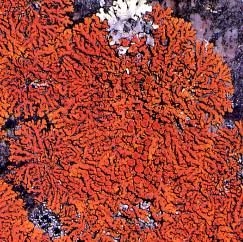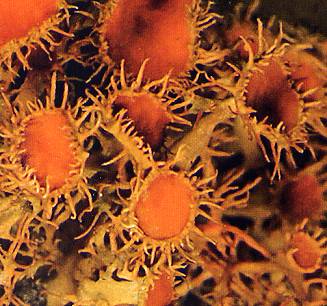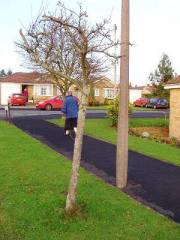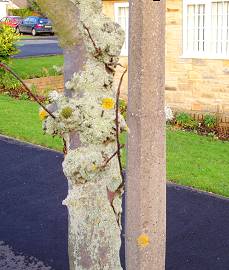Back to the Annual Report Contents and Home page
Towards the end of 2007 I didn’t think that I would have anything to report with no new species found. Many that I first came across over 10 years ago are still where I first noted them adding but a millimetre or so to their diameter each year.
 Then, in April, an observant Leicestershire County Council Highways Design Engineer, Lisa Bateman, discovered a bright orange lichen on the brickwork of a culvert. A British Lichen Society expert proclaimed it to be the Sunburst Lichen or Xanthoria elegans and explained that it is more commonly found at the tops of mountains like K2 and Everest. The photograph shows a magnificent European specimen but the photograph in the Leicester Mercury showed a specimen that was only about 1.5 inches across consisting of about 14 strands like the two forming a ‘V’ at the top of the photo next to the white lichen.
Then, in April, an observant Leicestershire County Council Highways Design Engineer, Lisa Bateman, discovered a bright orange lichen on the brickwork of a culvert. A British Lichen Society expert proclaimed it to be the Sunburst Lichen or Xanthoria elegans and explained that it is more commonly found at the tops of mountains like K2 and Everest. The photograph shows a magnificent European specimen but the photograph in the Leicester Mercury showed a specimen that was only about 1.5 inches across consisting of about 14 strands like the two forming a ‘V’ at the top of the photo next to the white lichen.
In August, accompanying a group of fungus and lichen enthusiasts back to the Darlington home of the chairman of the NE area Mycological Society, I glanced down at his sandstone doorstep to see what might have taken root (except that lichens don’t have roots). There, to my and everyone else’s amazement, were 3 or 4 tiny orange-red strands of X. elegans. I have been running a fairly regular lichen workshop for the best part of a year and a half. One young lady, Caroline Falvey, has made great strides in lichen recognition, so much so that Major Tony Crease, in charge of the Nature Reserve, Foxglove Covert at Catterick, persuaded her to put on a lichen display at the Field Centre which received an accolade from David Bellamy. In our revisiting of previously surveyed churchyards we discovered the X. elegans at Holy Trinity yard at Wensley and in St.Theobald’s churchyard at Great Musgrave, below Brough on the A66.
 Then, in December 2007, another special find was reported from a
Herefordshire orchard – the Golden Eye Lichen – Teloschistes
chrysophthalmus. The last recorded sighting was in 1966 and the species
was considered extinct. Two lichenologists were examining various
sites for the Herefordshire Orchards Evaluation Project. The lichen was
found on a fallen branch beneath an apple tree. It will take some
considerable climbing ability to check for any further specimens. Air
pollution is blamed for its apparent dying out. A photograph of the actual
specimen found can be seen by searching for ‘Golden Eye Lichen’ on the internet.
Then, in December 2007, another special find was reported from a
Herefordshire orchard – the Golden Eye Lichen – Teloschistes
chrysophthalmus. The last recorded sighting was in 1966 and the species
was considered extinct. Two lichenologists were examining various
sites for the Herefordshire Orchards Evaluation Project. The lichen was
found on a fallen branch beneath an apple tree. It will take some
considerable climbing ability to check for any further specimens. Air
pollution is blamed for its apparent dying out. A photograph of the actual
specimen found can be seen by searching for ‘Golden Eye Lichen’ on the internet.
However, I must admit that I believe this modern urge to find English names for every living organism quite ludicrous, and often misleading, despite the professed reasoning being to make them more ‘palatable’ to the general public. The very common, large orange leafy lichen found on trees, farmhouse barns and rooftop ridge tiles, Xanthoria parietina, is also variously known as ‘Common orange lichen’, ‘Yellow scale’, ‘Shore lichen’, and even the ‘Maritime Sunburst lichen’ whereas the single name, X. parietina is known the world over to lichenologists whatever national language is spoken.

 Coming back to earth, and leaving rarities aside, I never
fail to be amazed, and delighted, at the wealth of common
species that have settled around our own homes, on other
house roofs, the street kerbs and footpath trees. Across our
hedge, Xanthoria parietina colours the roof ridge tiles of
the bungalow opposite. This species just loves the rich
fertiliser obligingly provided by the parading starlings. My
small grove has just three trees in the verge. The nearest
is a rowan, the next an almond which every year litters the footpath with its fruits. I haven’t decided what the third one is, it’s been so hacked about. Close up, however, as you can see from the photo, the grey represents a dense clothing of a grey/green species, Physcia adscendens. You can just make out over half way up, the orange rosette of Xanthoria parietina, a relative of the Sunburst lichen, level with another on the extreme left. This species is also present, lower down on the concrete lamp standard. You canít see from this photo, but further down on the trunk is a smaller thallus of orange X. polycarpa and even lower, a small swathe of similar coloured X. candelaria, like a microscopic patch of orange lettuce leaves.
Coming back to earth, and leaving rarities aside, I never
fail to be amazed, and delighted, at the wealth of common
species that have settled around our own homes, on other
house roofs, the street kerbs and footpath trees. Across our
hedge, Xanthoria parietina colours the roof ridge tiles of
the bungalow opposite. This species just loves the rich
fertiliser obligingly provided by the parading starlings. My
small grove has just three trees in the verge. The nearest
is a rowan, the next an almond which every year litters the footpath with its fruits. I haven’t decided what the third one is, it’s been so hacked about. Close up, however, as you can see from the photo, the grey represents a dense clothing of a grey/green species, Physcia adscendens. You can just make out over half way up, the orange rosette of Xanthoria parietina, a relative of the Sunburst lichen, level with another on the extreme left. This species is also present, lower down on the concrete lamp standard. You canít see from this photo, but further down on the trunk is a smaller thallus of orange X. polycarpa and even lower, a small swathe of similar coloured X. candelaria, like a microscopic patch of orange lettuce leaves.
Why don’t you look around your own neighbourhood and see what you can find? I will always come round to see anything you find, if invited. They will still be there when all the flowering plants have packed up for the winter.
Back to the Annual Report Contents and Home page
 Then, in April, an observant Leicestershire County Council Highways Design Engineer, Lisa Bateman, discovered a bright orange lichen on the brickwork of a culvert. A British Lichen Society expert proclaimed it to be the Sunburst Lichen or Xanthoria elegans and explained that it is more commonly found at the tops of mountains like K2 and Everest. The photograph shows a magnificent European specimen but the photograph in the Leicester Mercury showed a specimen that was only about 1.5 inches across consisting of about 14 strands like the two forming a ‘V’ at the top of the photo next to the white lichen.
Then, in April, an observant Leicestershire County Council Highways Design Engineer, Lisa Bateman, discovered a bright orange lichen on the brickwork of a culvert. A British Lichen Society expert proclaimed it to be the Sunburst Lichen or Xanthoria elegans and explained that it is more commonly found at the tops of mountains like K2 and Everest. The photograph shows a magnificent European specimen but the photograph in the Leicester Mercury showed a specimen that was only about 1.5 inches across consisting of about 14 strands like the two forming a ‘V’ at the top of the photo next to the white lichen.
 Then, in December 2007, another special find was reported from a
Herefordshire orchard – the Golden Eye Lichen – Teloschistes
chrysophthalmus. The last recorded sighting was in 1966 and the species
was considered extinct. Two lichenologists were examining various
sites for the Herefordshire Orchards Evaluation Project. The lichen was
found on a fallen branch beneath an apple tree. It will take some
considerable climbing ability to check for any further specimens. Air
pollution is blamed for its apparent dying out. A photograph of the actual
specimen found can be seen by searching for ‘Golden Eye Lichen’ on the internet.
Then, in December 2007, another special find was reported from a
Herefordshire orchard – the Golden Eye Lichen – Teloschistes
chrysophthalmus. The last recorded sighting was in 1966 and the species
was considered extinct. Two lichenologists were examining various
sites for the Herefordshire Orchards Evaluation Project. The lichen was
found on a fallen branch beneath an apple tree. It will take some
considerable climbing ability to check for any further specimens. Air
pollution is blamed for its apparent dying out. A photograph of the actual
specimen found can be seen by searching for ‘Golden Eye Lichen’ on the internet.

 Coming back to earth, and leaving rarities aside, I never
fail to be amazed, and delighted, at the wealth of common
species that have settled around our own homes, on other
house roofs, the street kerbs and footpath trees. Across our
hedge, Xanthoria parietina colours the roof ridge tiles of
the bungalow opposite. This species just loves the rich
fertiliser obligingly provided by the parading starlings. My
small grove has just three trees in the verge. The nearest
is a rowan, the next an almond which every year litters the footpath with its fruits. I haven’t decided what the third one is, it’s been so hacked about. Close up, however, as you can see from the photo, the grey represents a dense clothing of a grey/green species, Physcia adscendens. You can just make out over half way up, the orange rosette of Xanthoria parietina, a relative of the Sunburst lichen, level with another on the extreme left. This species is also present, lower down on the concrete lamp standard. You canít see from this photo, but further down on the trunk is a smaller thallus of orange X. polycarpa and even lower, a small swathe of similar coloured X. candelaria, like a microscopic patch of orange lettuce leaves.
Coming back to earth, and leaving rarities aside, I never
fail to be amazed, and delighted, at the wealth of common
species that have settled around our own homes, on other
house roofs, the street kerbs and footpath trees. Across our
hedge, Xanthoria parietina colours the roof ridge tiles of
the bungalow opposite. This species just loves the rich
fertiliser obligingly provided by the parading starlings. My
small grove has just three trees in the verge. The nearest
is a rowan, the next an almond which every year litters the footpath with its fruits. I haven’t decided what the third one is, it’s been so hacked about. Close up, however, as you can see from the photo, the grey represents a dense clothing of a grey/green species, Physcia adscendens. You can just make out over half way up, the orange rosette of Xanthoria parietina, a relative of the Sunburst lichen, level with another on the extreme left. This species is also present, lower down on the concrete lamp standard. You canít see from this photo, but further down on the trunk is a smaller thallus of orange X. polycarpa and even lower, a small swathe of similar coloured X. candelaria, like a microscopic patch of orange lettuce leaves.